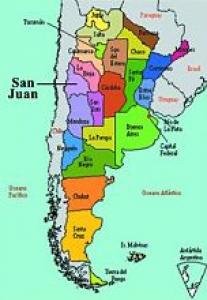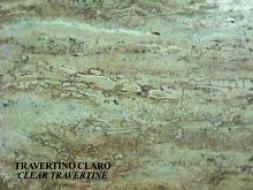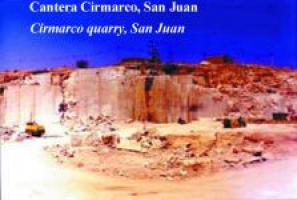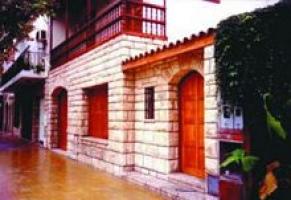San Juan is one of the three provinces most important producers of marble in Argentina, along with Cordoba and Buenos Aires. Of this production, can be highlighted travertine marble for its quality and for being exploited since the end of XIX century, which has noticed since then a clear preference for the use of ornamental rocks in public buildings and in the houses of the rich people, both in San Juan as well as in Mendoza and Cordoba. The deposits are located in a basin with geothermal activity, used for therapeutical ends in pre-Columbian age, situated about 45 km north of the capital city in La Laja, Department of Albardon.


The distance to the ports of Atlantic Ocean varies from 1200 to 1800 km, while towards the Pacific oscillates between 450 and 650 km, crossing the Cordillera de Los Andes. The region is dry and semi desert, with very dry and scarce water, the temperature varying from 42º C in summer and -6º in winter, with summer rains that do not exceed 50 mm annually. The general height oscillates around 750 m above sea level and one some days exceeds 95%.
Physical - Mechanical Characteristics
In San Juan there is a distinction between two types of travertine, dark and clear, that can be cut along the veins or "to the water" (parallel to it).


The physic-mechanical tests according to the norms of the European Community, UNE (Unification of Spanish Norms) and UNI (Unification of Italian Norms), were realised in the laboratory of Mechanica de Rocas del Instituto de Investigaciones Mineras, in the Institute Geominero in Madrid (Spain), and in the Dipartimento di Georisorse e Territorio, of the Politecnico di Turino (Italy).
According to these results one can conclude that the quality of travertine of San Juan completes with the requirements established for this type of rocks in the European Union.
ENSAYOS TRAVERTINO CLARO TRAVERTINO OSCURO TESTS CLEAR TRAVERTINE DARK TRAVERTINE Porosidad/Porosity (%) 4,02 5,72 Absorción/Absortion (%) 1,65 2,48 Pe aparente/Apparent Pe (%) 2,43 2,30 Pe aparente en H2O / 2,53 2,43 Apparent Pe in H2O Compresión/Compression (Kg/cm2) 479,45 Compresión T/Compression T (Kg/cm2) 503,91 716,00 Flexión/Flextion (Kg/cm2) 150,00 101,12 Resistencia al choque/ 35 cm 20 cm Resistance to blows Resistencia al desgaste/ 40 40 Wear resistance (%) Dilatación Térmica/ 4,9x10-6 °C 4,7x10-6 °C Thermic dilatation Microdureza / Micro-strength 1,63 ----
Methods of exploitation
There are 5 quarries in San Juan with fronts that vary between 50 and 50 metres length, in banks of 2 to 12 height.
The traditional method consists of perforation with hand drill realised in straight lines with space of 4 to 8 cm between drills, and loading one of each 10 with black gunpowder.
Currently, the main quarries operate with diamond cable and chain saws with teeth of widia, in fronts that go from 4 to 12 m height. The blocks are separated from the front by means of hydro-pneumatics wedges and received one "bed" of fine material.
Labour
The quarries functioning normally employ between 6 and 10 workers each, totalling an average of 30 to 50 people. At the same time, the three plants or saws each employ 10 to 15 workers, with a total of 30 to 45 permanent workers. (Perucca et al 1984).
If to these personnel one adds those in transport and other workers in accessory tasks (administration, truck repair, workshop mechanics, spare parts, etc.) one can assume that the number of people related to the mining of travertine marble in San Juan exceed 120.


Uses
In this region (San Juan, Mendoza, San Luis, La Rioja) there exists a clear tendency towards the use of natural stone in the construction of residential buildings of medium to high level, in great part helped by the dry climate that keeps the fronts clean and unaltered. In the rest of the country, the use of stone is limited to public buildings, banks and monuments, except in certain touristic centres such as Mar del Plata and Cordoba, where one can appreciate the particular tastes for granite and quartzite that is extracted in the respective neighbourhood.
In the city of San Juan there exists a marked preference for the use of travertine marble in construction of fountains and gardens, both in houses as well as public buildings. One of the most common applications is, cutting in small blocks applied in supports by hand finished in general. Another very common form is to install it in polished slabs as cladding, especially in front of public buildings.
In recent times the use has started, increasingly with greater intensity, of a combined form of ornamentation of facades integrating the fronts or walls with diverse materials: various marbles, travertine, limestone or blocks of sandstone, with polygonal multicolour design. With this system one gets a great number of variety of forms, type and colour, with striking and exclusive solutions, a reason that explains its exclusivity.
In a statistical analysis it was observed that in the centre of the capital city about 53% of family houses have fronts with marble, granites, porphyry, quartzite and sedimentite of different types. In the commercial centres, banks and public offices, the use of polished slabs in fronts and staircases reaches 70%.
A very particular use is in monuments in streets and squares, as well as fronts in historical buildings. In this sense, making use of the ease of working because of low level of strength and the great number of craftsmen that exist in San Juan, the soft and clear and very homogenous colour, is also an important attraction, added to the traditional taste of the people of this region for all artistic manifestation related to the use of natural elements such as regional stone and wood.
There is competition generated by other varieties of sedimentary and metamorphic marbles, almost all produced also in San Juan (Marroquí, Lunel, Bardiglio, Cipollino, white type Carrara, Ciampo Venato, Andine Black and other diverse commercial names), apart from the granites proceeding from Cordoba, San Luis, Buenos Aires and Brazil.
